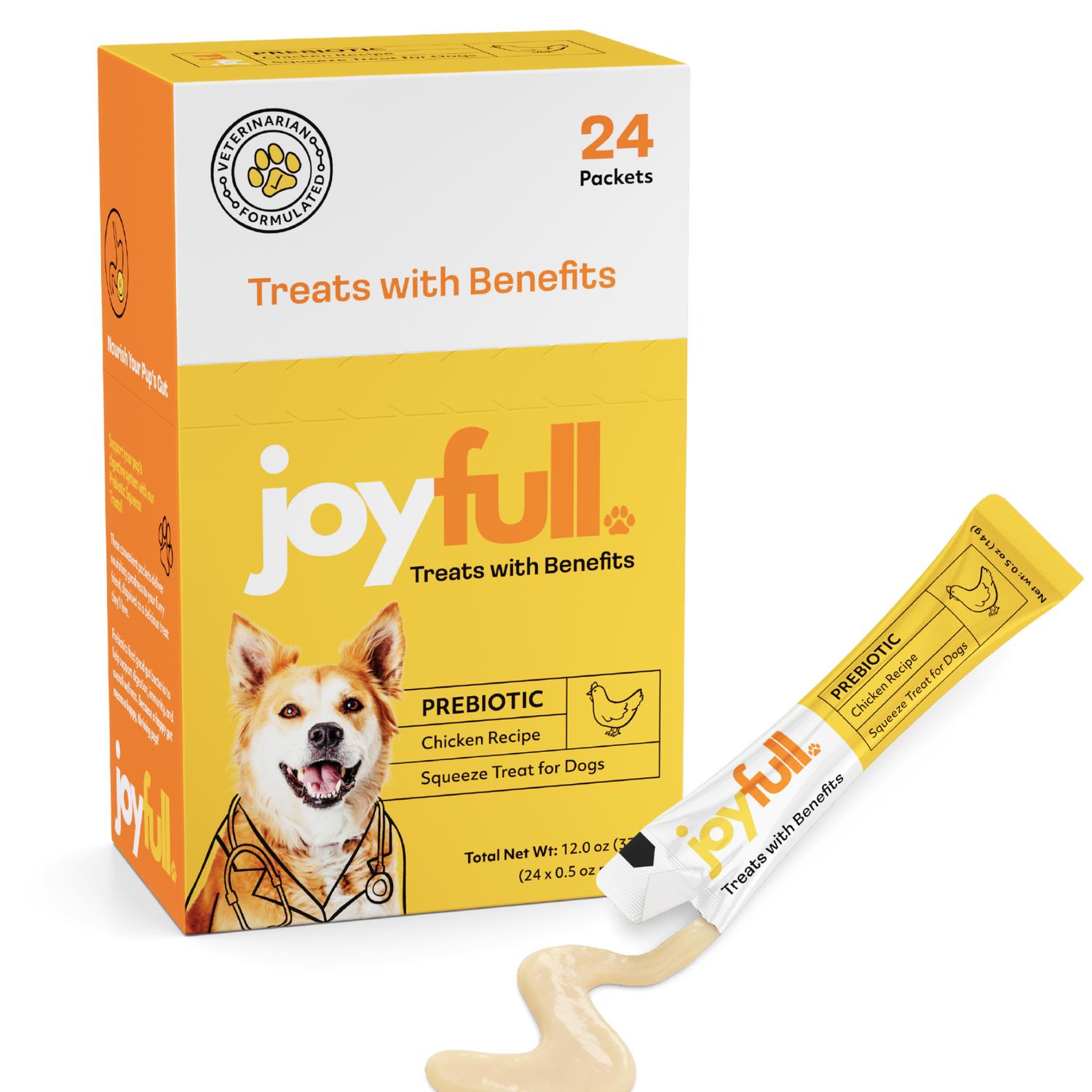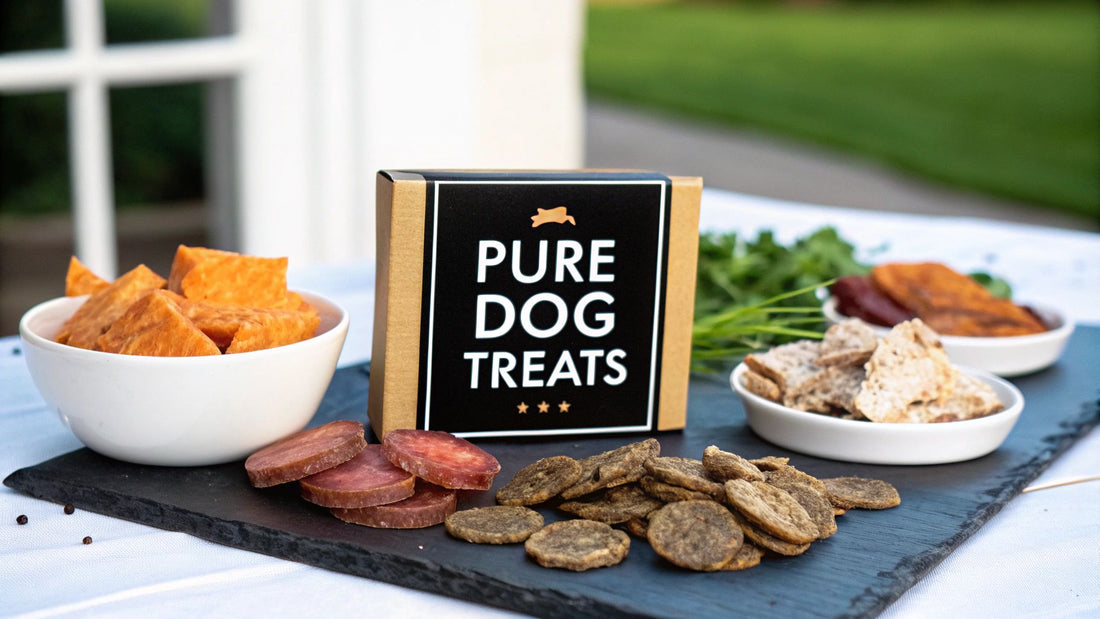
Finding the Best Single Ingredient Dog Treats
When it comes to the best single-ingredient dog treats, my go-to recommendations are almost always dehydrated meats. Things like chicken jerky, beef liver, or fish skins are absolute powerhouses of protein and key nutrients, all without the junk.
If you're looking for a great plant-based option, you can't go wrong with dehydrated sweet potato chews—they’re packed with fiber and naturally low in fat. The bottom line is simple: the fewer ingredients, the better.
Why Simple Treats Are a Smarter Choice
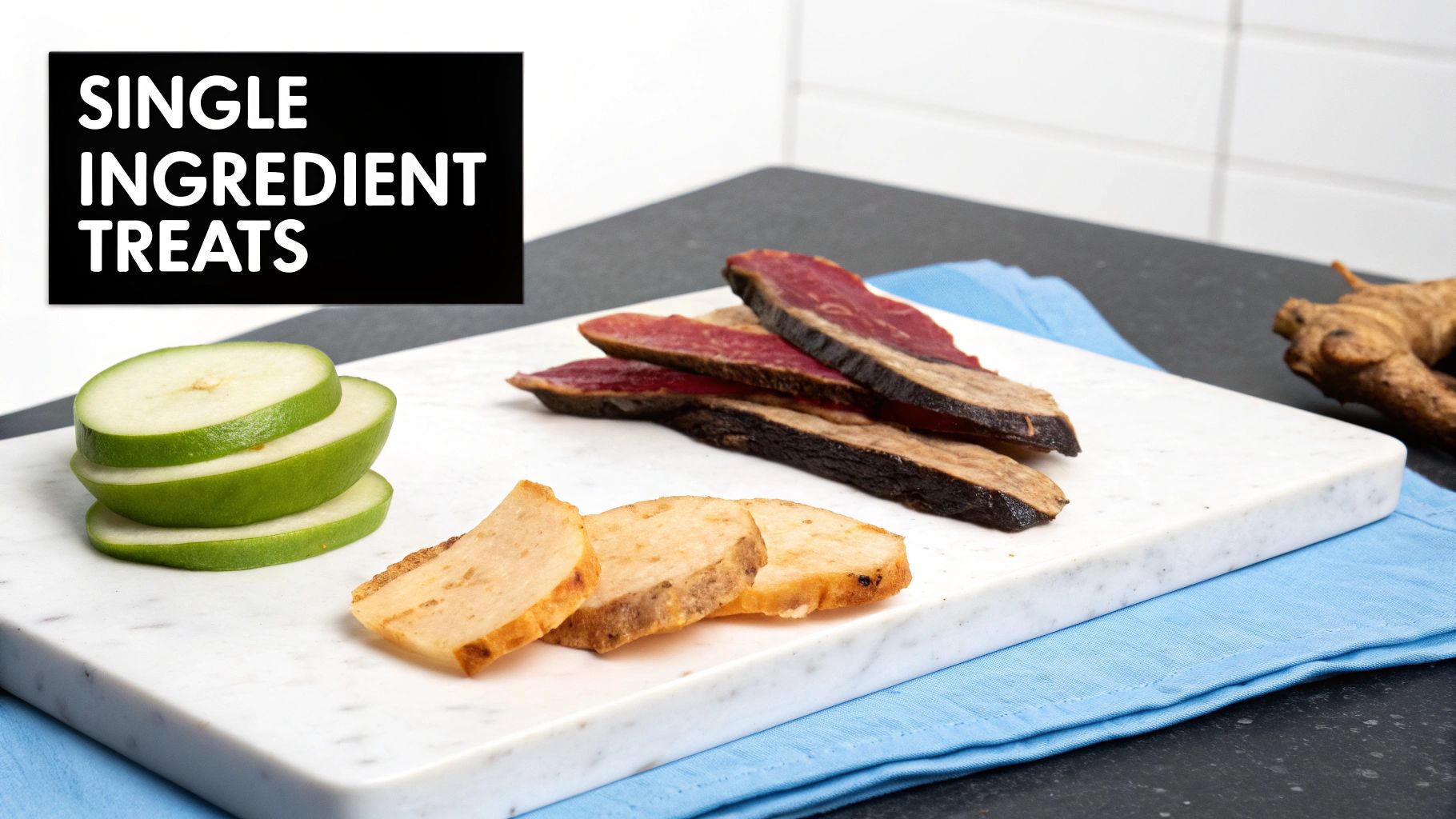
Walking down the pet treat aisle can feel completely overwhelming. The bags are bright, the claims are big—promising everything from shiny coats to perfect teeth. But flip one over, and you’re often met with a massive list of fillers, artificial preservatives, and ingredients you can't even pronounce. It doesn't have to be that complicated.
This is where the beauty of single-ingredient dog treats really shines. It’s a lot like how we choose our own food. You could grab a bag of processed cheese puffs with a paragraph of ingredients, or you could pick up an apple. With the apple, what you see is what you get. Single-ingredient treats give you that same wonderful transparency for your dog.
The Power of One Ingredient
The idea is refreshingly simple: each treat is made of just one thing. That could be a slice of dehydrated sweet potato, a piece of freeze-dried beef liver, or an air-dried cod skin. Nothing else.
You won't find any grains, fillers, artificial colors, or strange chemical preservatives. This "less is more" philosophy brings some serious benefits, both for your dog's health and your own peace of mind.
This isn’t just a passing trend. It’s part of a bigger shift in how we think about our pets’ nutrition. The global pet treats market is expected to hit around $26.7 billion by 2025, and a huge part of that growth comes from owners like us who want more natural, wholesome choices for our dogs.
To help you navigate these options, here's a quick look at some popular single-ingredient treats and what makes them great.
Top Single Ingredient Treats at a Glance
| Treat Category | Common Examples | Primary Benefits |
|---|---|---|
| Meat Jerkies | Chicken, beef, turkey, duck | High in protein, great for muscle development, and highly palatable for picky eaters. |
| Organ Meats | Beef liver, chicken hearts | Nutrient-dense, packed with vitamins like A and B, iron, and essential fatty acids. |
| Fish-Based Treats | Salmon skins, cod skins, minnows | Rich in Omega-3 fatty acids, which support healthy skin, a shiny coat, and joint health. |
| Vegetable Chews | Sweet potato, carrots | Excellent source of fiber for digestive health, low in fat, and rich in vitamins. |
This table just scratches the surface, but it shows how you can target specific health benefits just by choosing the right single ingredient.
Knowing exactly what’s in your dog's treats is one of the most important things you can do as a pet owner. Choosing the healthiest treats you can trust helps you make smart, confident decisions every time you want to give your best friend a little something special.
Unpacking the Health Benefits of Simplicity
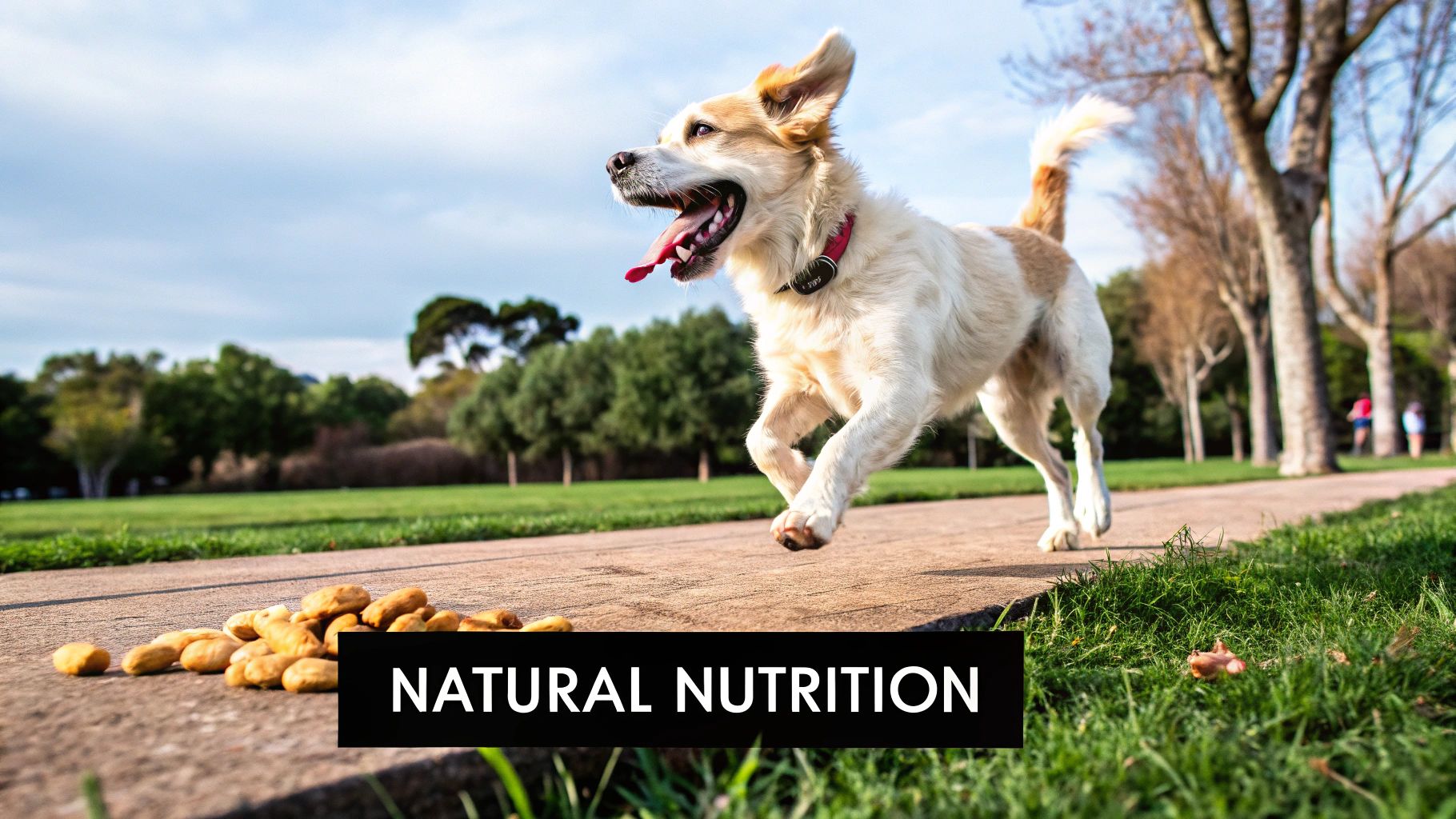
When you choose single-ingredient dog treats, you’re not just jumping on a minimalist trend—you’re making a proactive choice for your dog's health. Think about it: grabbing a complex, multi-ingredient treat off the shelf is kind of a gamble. It's a mystery box filled with ingredients you can't pronounce, and you never quite know how your dog will react to the cocktail of fillers, artificial flavors, and preservatives inside.
A single-ingredient treat, on the other hand, is completely transparent. If you give your dog a dehydrated sweet potato slice, you know exactly what they're eating: sweet potato. This clarity is a total game-changer, especially for the countless dogs out there with sensitive systems.
Solving Common Digestive and Allergy Issues
For any dog owner who's dealt with a sensitive stomach or food allergies, finding a safe treat can feel like navigating a minefield. The culprit is often a single hidden ingredient—like wheat, corn, or soy—tossed in as a cheap filler. Artificial additives are just as bad, often triggering everything from itchy skin and hotspots to full-blown digestive upset.
Single-ingredient treats take all that guesswork out of the equation. By sticking to one, pure component, you dramatically lower the odds of setting off an allergic reaction. This approach also makes it so much easier to pinpoint exactly what your dog can and can't handle through a simple process of elimination.
Key Takeaway: When you control the ingredients, you control the outcome. Simplicity means you can reward your dog without secretly worrying about the fillers and allergens that could cause discomfort later.
This shift toward clean, transparent pet food isn't just a fad. North America is now the leading market for single-ingredient pet treats, a change driven almost entirely by owners who see their pets as family and demand natural, additive-free options. This push from consumers is making healthier treats more accessible than ever for dogs with allergies or dietary restrictions. You can learn more about the rise of single-ingredient pet treats and how it’s changing the industry.
Boosting Dental and Digestive Health Naturally
The benefits of simplicity go well beyond just managing allergies; they impact your dog’s everyday wellness, too. The physical makeup and texture of these treats can play a huge role in their overall health.
-
Natural Dental Care: Many single-ingredient chews, like beef tendons or fish skins, are naturally tough and fibrous. As your dog gets to work gnawing on them, that abrasive action helps scrape away plaque and tartar buildup from their teeth. It’s an effective way to support oral hygiene without any weird dental additives.
-
Improved Digestion: A dog’s digestive system is built to process whole foods. Treats free from complex carbs and synthetic chemicals are far easier for their bodies to break down, allowing for better nutrient absorption. The result is a happier gut and more predictable digestion.
Ultimately, choosing the best single ingredient dog treats is one of the most straightforward ways to reward your dog while actively supporting their health. From keeping allergies at bay to helping clean their teeth, the power really is in simplicity.
How to Choose the Right Treat for Your Dog
Picking out the perfect single-ingredient treat isn't as simple as grabbing the first bag you see on the shelf. Think of yourself as your dog's personal chef—you need to cater to their specific tastes and dietary requirements. After all, what works for a tiny senior Chihuahua is a world away from what a young, power-chewing German Shepherd needs.
The best place to start is by looking at your dog's unique profile. Their size, age, and chewing style are the three most critical factors to get right.
Start With Your Dog's Profile
-
Size and Age: A big, tough chew could be a serious choking hazard for a small breed or a dental nightmare for a senior dog with fragile teeth. On the flip side, a tiny, soft treat might disappear in seconds for a large dog, offering zero satisfaction or dental benefit. Puppies need softer options to protect their developing teeth, while seniors usually appreciate something gentle on their gums.
-
Chewing Style: Do you have a delicate nibbler on your hands, or a "power chewer" who can demolish a toy in minutes? Knowing this will guide you to the right durability. Softer treats like freeze-dried liver are fantastic for training, but tougher chews like beef tendons provide longer-lasting mental stimulation for dogs that love a good gnaw.
Understand How the Treat is Made
Once you've sized up your dog, the next step is to look at how the treat was prepared. The processing method has a massive impact on a treat’s final texture, its nutritional value, and how long it stays fresh.
How a treat is made can tell you a lot about its final form. Let's break down the most common methods you'll see.
Comparing Treat Processing Methods
| Processing Method | How It Works | Nutritional Impact | Best For |
|---|---|---|---|
| Dehydrated | Low heat is applied over many hours to slowly evaporate moisture. | Good nutrient retention, creating a dense and chewy final product. | Dogs who love a satisfying, long-lasting chew. |
| Freeze-Dried | The ingredient is flash-frozen, then placed in a vacuum to turn ice directly into vapor. | Excellent nutrient retention. Results in a light, porous, and often crumbly texture. | Training, food toppers, or senior dogs with sensitive teeth. |
| Air-Dried | Circulating air, often with little or no heat, gently removes moisture over time. | High nutrient and flavor retention. Texture can range from chewy to firm. | An all-around great option that preserves the "raw" qualities of the ingredient. |
As you can see, each method offers a different outcome. It’s all about finding the right match for your dog's chewing habits and your nutritional goals.
Choosing a processing method is a bit like deciding how to cook vegetables. Steaming (like freeze-drying) keeps the most nutrients intact, while roasting (like dehydrating) creates a richer, chewier texture. Each has its own benefits.
To see this in action, take a look at how different single ingredients stack up nutritionally.
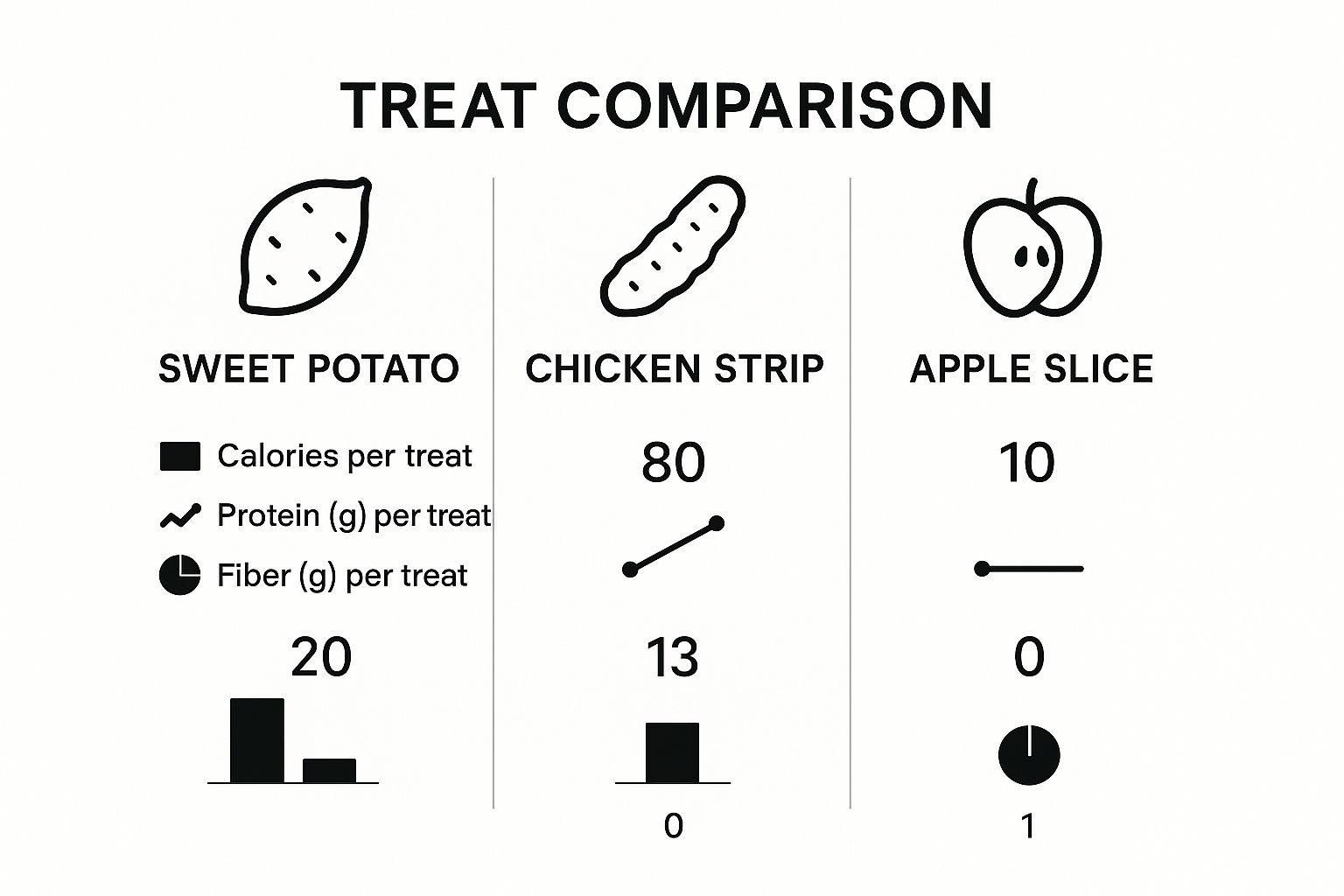
This simple comparison highlights how ingredients offer different perks—from the high protein in chicken to the rich fiber in sweet potato.
When you match your dog’s profile with the right ingredient and processing style, you can confidently choose the best single ingredient dog treats that are not only safe but genuinely beneficial for them.
Our Favorite Animal and Plant-Based Treats
https://www.youtube.com/embed/eDtp6SOnhDY
Alright, now that you know what to look for, let's get to the fun part: picking some amazing treats. The great thing about single-ingredient options is how simple they are. Everything falls into one of two buckets: animal-based or plant-based. This makes it so much easier to find that perfect high-value reward or a healthy chew your dog will go crazy for.
And we're not the only ones catching on. The demand for these straightforward, healthy treats is absolutely exploding. The global dog treats market is expected to jump from USD 44.2 billion in 2025 to an incredible USD 336.3 billion by 2035. A huge driver behind this is pet parents like us who are actively seeking out minimally processed treats, like dehydrated meats and veggies. You can dig deeper into the stats and see how consumer preferences are shifting in this booming dog treat market analysis.
Power-Packed Animal-Based Treats
When it comes to training, animal-based treats are usually the gold standard. They're packed with protein for energy and muscle support, and most dogs find them completely irresistible.
- Beef Liver: I often call this "nature's multivitamin." Whether it's freeze-dried or dehydrated, beef liver is a powerhouse of iron, copper, zinc, and vitamins A and B. Its intense, rich flavor makes it a home-run for even the fussiest eaters.
- Chicken Jerky: A timeless classic for good reason. As long as it's made from 100% chicken breast with zero additives, it's a fantastic lean protein source. Just double-check that it's sourced and produced in a country with strict safety standards to avoid any nasty contaminants.
- Salmon Skins: These are amazing. The crunchy, chewy texture keeps dogs busy, and they're loaded with omega-3 fatty acids. Those healthy fats are key for a shiny coat, healthy skin, and good joint function, making them a top pick for active pups or breeds prone to skin issues.
These treats don't just taste good; they deliver real, targeted nutrition that taps into a dog's natural carnivorous instincts.
Pro Tip: Always check the label. You want to see specific cuts of meat listed, like "beef lung" or "chicken breast." If you see vague terms like "meat by-products," it's usually a sign to put the bag back on the shelf. That kind of transparency says a lot about the quality.
Wholesome Plant-Based Alternatives
Don't overlook the veggies! Plant-based treats are a fantastic low-fat, high-fiber alternative. They're perfect for dogs needing to watch their weight, those with sensitivities to certain animal proteins, or just as a way to mix things up.
- Sweet Potato Chews: Simple dehydrated slices of sweet potato are naturally sweet, wonderfully chewy, and full of fiber for digestive health. Plus, they're a great source of beta-carotene, an antioxidant that the body converts to vitamin A.
- Dehydrated Carrot Slices: For a low-calorie crunch, you can't beat carrots. They're an ideal guilt-free treat for dogs on a diet, and they deliver vitamins and minerals that help support vision and a healthy immune system.
- Apple Slices: As long as they're dehydrated with no added sugar, apple slices are a tasty, fibrous snack packed with vitamins A and C. Just be absolutely sure the core and seeds have been removed, since the seeds contain trace amounts of cyanide.
Whether you go for a protein-rich animal chew or a fibrous veggie slice, it all comes back to quality. If you're feeling a little adventurous and want to make your own, we've got some great ideas in our guide on 7 healthy dog treat recipes to make in 2025.
Introducing New Treats Without Upsetting Stomachs

We’ve all been there—you bring home a new bag of treats, and your dog's tail starts going a mile a minute. It’s exciting! But a dog’s digestive system often isn't a fan of surprises, and even the highest-quality single-ingredient treats can cause a gut revolt if introduced too fast.
The secret to keeping their stomach happy is to take it slow. Think about it this way: you probably wouldn't sit down to a massive, three-course meal of a cuisine you've never tried before. You'd start with a small taste. Your dog's gut needs that same courtesy to get used to something new, which helps you avoid any nasty surprises like vomiting or diarrhea.
The Start Low and Go Slow Method
When it comes to new treats, I live by one simple rule: "start low and go slow." This approach is your best defense against digestive upset and gives you a chance to spot any hidden sensitivities your dog might have.
Here’s a breakdown of how to do it right:
- Days 1-2: Start with a tiny piece, maybe just a quarter of a single treat. Then, just watch. For the next 24 hours, keep an eye out for any signs of trouble.
- Days 3-4: If everything looks good, go ahead and double the amount to about half a treat. Again, continue to monitor how they’re feeling.
- Day 5 & Beyond: Still no issues? Great! You can now confidently offer a full-sized treat.
Following this simple process makes treat time a genuinely positive experience, building trust and keeping your dog’s tummy happy.
Balancing Calories to Prevent Weight Gain
Treats are one of the best parts of being a dog, but it's easy to forget they have calories. To keep your dog at a healthy weight, you have to account for those little extras.
A fantastic guideline is the 10% rule: treats should never make up more than 10% of your dog's total daily calories. If you have a heavy training session, just pull back a little on their dinner portion to keep things balanced.
One last thing—always match the treat to your dog. A treat that’s too hard could be a risk to their teeth, while something super-rich like organ meat might be too much for a pup just starting with single-ingredient snacks. And no matter what, it's always smart to supervise your dog when they're enjoying a new chew. Better safe than sorry
Answering Your Questions About Single Ingredient Treats
Even when you see all the benefits laid out, it's totally normal to have a few questions before you dive in and overhaul your dog's treat jar. We all want to make the best choices for our dogs, and that starts with being well-informed. To help you feel completely confident, we've rounded up some of the most common questions we hear from pet parents just like you.
Think of this as your final Q&A session before you start exploring all the amazing options out there. We'll clear up any last-minute uncertainties so you can get right to rewarding your best friend with the simple goodness they deserve.
Are Single Ingredient Treats Safe for All Dogs?
For the most part, yes! But the real answer always comes down to your individual dog. Just like us, some dogs have specific allergies or sensitivities, often to common proteins like chicken or beef. The great thing about single-ingredient treats is that it's incredibly easy to pinpoint and avoid those triggers.
It's also about matching the treat to the dog. A super tough beef tendon might be a dream for a strong, adult power-chewer, but it could be way too much for a puppy's delicate teeth or a senior dog's sensitive gums. Always choose a treat with a size and texture that makes sense for your dog's age and chewing style.
How Many Single Ingredient Treats Can I Give My Dog?
The golden rule for any and all treats is the 10% rule. This is a simple but important guideline: treats, no matter how healthy, should never make up more than 10% of your dog's total daily calories. Following this helps prevent weight gain and ensures your dog is getting the balanced nutrition they need from their main meals.
Not sure how to figure that out? Your veterinarian is the best person to ask for advice tailored to your dog's specific health, weight, and activity level. On days when you're doing a lot of training, it's fine to be a little more generous with the rewards—just consider slightly reducing their dinner portion to keep things in balance.
Can I Make My Own Single Ingredient Treats at Home?
Absolutely! Making your own treats is a fantastic way to have total control over the quality while saving a bit of money. And honestly, it’s easier than you might think. A great starting point is dehydrating thin slices of lean meat (like chicken breast) or dog-safe veggies (like sweet potato) in a food dehydrator or even just your oven on its lowest setting.
Just be sure to stick to ingredients you know are safe for dogs. To play it safe, it’s always a good idea to know which ingredients to avoid in dog treats, because many foods we enjoy can be harmful to our pets.
Where Can I Find High Quality Single Ingredient Treats?
You can find great options at specialty pet boutiques, from reputable online brands, and sometimes even at your local farmers' market. The single most important thing to look for is transparency.
Look for brands that are open and proud about where their ingredients come from. Treats made and sourced in countries with high food safety standards—like the USA, Canada, or New Zealand—are usually a safe bet. The best companies will gladly tell you their story, giving you complete peace of mind about what you're feeding your dog.
At Joyfull, we are committed to providing clean, high-quality, and transparently sourced treats because we believe a healthful life isn’t just for humans—our pets deserve it, too. Explore our selection of no-BS, genuinely beneficial snacks at https://joyfullpet.com.
